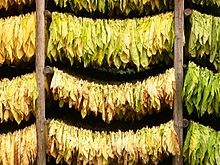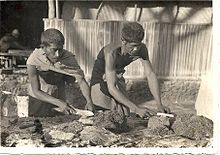Tobacco
![]()
The title of this article is ambiguous. For other meanings, see Tobacco (disambiguation).
Tobacco is a plant product made from the leaves of plants of the genus Nicotiana. Of the approximately 75 species of this genus, however, only two are important for tobacco production: the Virginian tobacco (Nicotiana tabacum) and the farmer's tobacco (Nicotiana rustica). The Nicotiana species are mainly native to South America, some also to Australia and North America.
The main constituents of tobacco include: Nicotine (a colorless alkaloid that is liquid at room temperature), ammonium salts, cellulose, and proteins. In small quantities also natural resin, plant wax, starch, sugar, tannic acid, malic acid, citric acid, oxalic acid and the inorganic ingredients nitrate, potassium, sodium, calcium, magnesium, iron and chlorine. In addition, the radioactive element polonium accumulates in the leaves. Although not all substances are yet known, it is estimated that, for example, a cigarette and its smoke contain about 6,000 to 12,000 different chemical substances.
Tobacco smoking has been proven to be harmful to health. According to data from the World Health Organisation, over 6 million people die each year as a result of tobacco consumption, around 10% of them from passive smoking. The economic damage amounts to around 950 billion dollars a year. While economic benefits are occasionally discussed, such as job creation and tobacco taxes, the overall negative environmental and social consequences of tobacco cultivation are substantial.

Fine Cut Tobacco

Work in a tobacco plantation

Tobacco flowers
Usage
As an American plant species, tobacco has always been used by many indigenous tribes of the Americas, but less as a stimulant and more as part of spiritual rituals (although this did not apply to the so-called peace pipe of the Prairie Indians, in which sweet grass and sage were burned). It was chewed, snuffed, smoked, eaten, juiced, rubbed on the body, used in eye drops and body wraps. Either concentrated tobacco juice was used by shamans as a psychotropic (intoxicating), very fast-acting substance, as among the Maya and Caribbean tribes; or the tobacco smoke was swallowed in large quantities into the stomach, as the hallucinogenic alkaloids could induce visions in this way, as among some rainforest ethnic groups in Amazonia.
Tribes used tobacco to treat:
- Earache,
- Snakebites,
- Cuts and burns,
- Respiratory,
- Fever,
- nervous disorders,
- Bladder problems,
- Skin diseases.
The Old World learned of the existence of tobacco plants and their use through the voyages of Columbus to America. The French envoy in Portugal Jean Nicot ensured the introduction of tobacco as a medicinal plant in France, after him later the generic name of the tobacco plant "Nicotiana" and at the same time the most important ingredient nicotine was named. In Europe, tobacco was first cultivated as a medicinal plant. Tobacco leaves were placed on open wounds and, in the case of stomach complaints, the sick person was supposed to drink tobacco juice. A herbal from 1656 says about tobacco: "This herb cleanses the palate and head, drives away pain and fatigue, soothes toothache, protects people from plague, chases away lice, heals the grind, burns, old ulcers, damage and wounds".
Around 1650, "The Great Elector" Frederick William settled Huguenots in his lands, which had been deserted as a result of the Thirty Years' War, and they introduced tobacco growing to his country. As early as 1666, immigrant Huguenots operated snuff and chewing tobacco shops in Mannheim. From 1688, tobacco cultivation spread from the Palatinate and from 1700 from the Baden village of Friedrichstal across the Hardt region between Karlsruhe and Mannheim and northern Germany.
The world raw tobacco harvest in 120 countries on an area under cultivation of 4.1 million hectares amounted to about 7.4 million tonnes in 2000. The world's largest tobacco grower was China, with 1.5 million hectares under cultivation and a production share of 2.6 million tonnes. FAO statistics put the area under tobacco cultivation at 3.4 million hectares in 1961 and 4.0 million hectares in 2010. This means an increase of 17% with an increase in the earth's population of 122%. In purely statistical terms, the area under tobacco cultivation, which in 1961 amounted to approx. 11 square metres per person, has thus fallen to 5.8 square metres by 2010 and has thus halved in relation to the earth's population.
As a crop plant for tobacco production, only two species are currently (2013) of economic importance, which form numerous varieties and from which many cultivars have been bred. The most widespread species is the Virginian tobacco (Nicotiana tabacum), to which almost all varieties cultivated today belong. After appropriate processing, the tobacco harvest is mainly used for cigarettes. In Germany, the varieties "Friedrichstaler", "Havanna", "Geudertheimer" and "Burley" were common until the end of the 20th century. These are dark varieties that were used for cigars and as an admixture to dark cigarettes. Virginia is a current variety used as an admixture in light cigarette brands. In Eastern Europe, peasant tobacco (Nicotiana rustica) is also grown and processed into machorka.
The fermented and chopped tobacco leaves (smoking herb) can be smoked in tobacco pipes or rolled as cigarettes, cigarillos and cigars. Much of the toxic nicotine is burned off; only a small amount evaporates and is inhaled. Less common is consumption in the form of smokeless tobacco, snus, chewing tobacco and snuff. Consumption by inhalation, snuff, or chewing is also associated with significant health risks, which can range from cardiovascular problems to circulatory problems, impotence, and various forms of carcinoma. Several of these risks are also associated with secondhand smoke and residual smoking. The use of tobacco products significantly increases the risk of nicotine dependence.
Water pipe tobacco consists of a mixture of tobacco and humectants (glycerol and/or propylene glycol) and may also contain aromatic oils, extracts, molasses or sugar or be flavoured with fruit.
The former use of tobacco broth as an insecticide is now banned because of the risk of nicotine residues in food.

Tobacco leaves drying
Distribution
Tobacco cultivation is the agricultural cultivation of tobacco as a crop for the production of raw tobacco from the harvested and dried leaves, sometimes also from the whole plants. Because of the great adaptability of the subtropical plant, tobacco is cultivated as far as the temperate zones from 38° south latitude to 56° north latitude. The main areas of cultivation are the People's Republic of China, North, Central and South America, Southeast Asia, the Near East/Balkans and Europe.
At the beginning of the 21st century, almost 90 % of the cultivated areas were in the southern countries. Tobacco cultivation is increasing particularly in the low- and middle-income countries of the tropical and subtropical landscape zones in Africa, Latin America and Asia, the emerging and developing countries of the South. During the period 1961-2002, the area under cultivation fell by 60% in the "First World" and increased by about 60% in the "Third World" during the same period. Examples of extreme increases in cultivation are Malawi with a doubling and Tanzania with a six-fold increase in 40 years. Tobacco cultivation in African growing regions leads to increased deforestation, humus depletion of the soil and strong economic dependence on tobacco buyers.
Tobacco cultivation in Europe was supported by the European Union with subsidies of up to one billion euros per year. Of this, around 150 million euros went to tobacco cultivation in Germany. From 2005 onwards, 20 per cent of EU payments were used specifically to encourage tobacco farmers to switch to other products. In 2010, subsidies for tobacco cultivation in the EU were discontinued; conversion subsidies could be applied for until 2013.

Tobacco processing in Portuguese Timor in the 1930s
Search within the encyclopedia